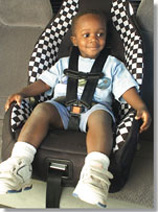In Spanish
In Hmong
In Somali
Installation Checklist 4: Combination Car Seat
Important: This is a general checklist designed to be used in combination with your vehicle owner’s manual and your child car seat instruction manual. To get the most out of this checklist, have those manuals handy for quick reference.
A combination seat can be used with the 5-point harness system or as a belt-positioning booster seat without the harness.
 ___ 1) Check that the car seat is correct for the child’s weight and height. ___ 1) Check that the car seat is correct for the child’s weight and height.- The seat is used with the 5-point harness for children 20 to 65 – 85 pounds (depending on the seat) and more than one year old. At 40 pounds, the harness straps should be removed and the child should use the vehicle lap and shoulder belt with the booster seat. Some combination seats may be used without the harness straps as a booster seat up to 80 – 100 pounds. (Height and weight limits vary by manufacturer; check labels on the car seat for specific limits.) Note: once seat has been converted to a booster seat, you must use it with the vehicle’s lap and shoulder belt.
___ 2) Place the car seat in the back seat of the vehicle.- If vehicle is an SUV or van with three rows of seats, place the car seat in the middle row.
- Place the car seat in the center of the vehicle seat, if possible. See the vehicle owner’s manual for details).
- The car seat should face the front of the vehicle.
The remaining instructions apply to use of the combination seat with the 5-point harness.
___ 3) Select one method only to install the car seat.- Lap belt only (usually found in middle of back seat)
- Lap and shoulder belt
- LATCH system (Lower Anchors and Tethers for Children, built into the vehicle – see below)
___ 4) Attach the car seat.
Important: You must check labels on the car seat and the car seat instruction manual for information on how to attach the car seat using either the lap belt, lap and shoulder belt, or LATCH system. Also check your vehicle owner’s manual for instructions, including whether you need to use a locking clip.
___ 5) Tighten the vehicle belt or lower anchor attachment (LATCH).- The car seat must not move more than one inch from side to side or front to back at the point of attachment. Have another person push down firmly on the child car seat while you tighten the vehicle belt, or kneel on the car seat yourself while you tighten the vehicle belt.
- Attach the top tether and tighten.
___ 6) Buckle the child into the car seat (see photo).- Use the harness for children 20 - 40 pounds (or 65 - 85 pounds depending on the seat) and more than one year old. Harness straps should be at or above the child’s shoulders.
- Check that the harness straps are snug and flat on the child’s shoulders.
- Check that the plastic harness retainer clip is at the child’s armpit level.
- The child’s back should be flat against the back of the car seat.
Note: Remove the harness and use as a belt-positioning booster seat with a lap and shoulder belt when the child reaches the maximum weight and height limits on the harness.
Source: National Highway Traffic Safety Administration, U.S. Department of Transportation
See how to do it on video: "Safety Seats for Your Toddler" and "Booster Seats for Your 4- to 8-year-old Child" linked from http://www.chop.edu/carseat
|
|
|
|
|


 ___ 1) Check that the car seat is correct for the child’s weight and height.
___ 1) Check that the car seat is correct for the child’s weight and height.